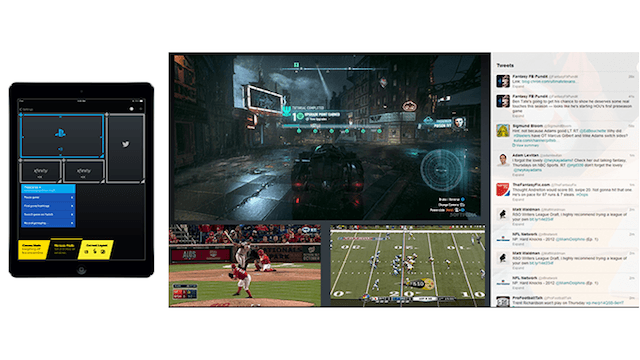With just seven days left of its incredibly successful Kickstarter, is Skreens set to become the future of how we consume digital media?
What does the future hold for displays? Is it an ever increasing number of pixels, faster refresh rates, and bigger screens?
We’ve pretty much reached an apex when it comes to the way our content is output. Sure, we could try and make it all bigger, faster and sharper, but maybe the question is should we? Maybe there’s a better way to utilize what we already have, and start pushing display technology in a new, exciting direction. With just under one week remaining of an incredibly successful Kickstarter, company CEO and founder Marc Todd’s vision of a new way for users to consume digital content may become reality, thanks to Skreens.
What is it?
If you were to describe Skreens to someone as quickly as possible, you would say it was a box that allowed you to connect multiple HDMI devices to it – such as a console, Blu-ray, PC, Roku, GoPro etc. – and output them all simultaneously onto one screen at 1080p/60fps. But that’s just the short version; the reality is that it can do so much more.
Being able to seamlessly combine multiple HDMI signals into one high definition output – and with absolutely no lag – is a Herculean feat in itself, yet Marc and his team of engineering experts have managed to achieve this with a device that measures 1” X 4.75” X 3” and costs $199 – $450.
As anyone who has watched the videos that show off this amazing technology will tell you, one of the most exciting aspects of Skreens is the ability it gives users to control the layout of each feed that appears on a display – all in real-time and without stuttering. You get to decide which feeds go on your TV, where they’re positioned and what size they are, all using the incredibly intuitive Skreens app for iOS or Android. You can save your preferred layouts, and there are some predefined ones built-in and ready for use. Additionally, developers can get into the RESTful API to make their own controls.
Gaming and other applications
Skreens offers a huge number of possibilities when it comes to gaming setups and watching TV. Imagine playing a PS4/Xbox One game on your television with Twitter and Facebook both open at the side of the screen, or how about watching a sporting event with a betting/fantasy football league website open alongside it – all while your favorite YouTuber sits in the corner and provides a running commentary. Moreover, at its most basic, Skreens is the only way you’ll be able to play Halo 5 in split-screen!
It’s worth mentioning at this point that every Skreens model comes with a built-in Chromium browser, WiFi, and ethernet port, so you don’t even have to plug in any internet-enabled devices to view web content.
Applications for Skreens aren’t limited to games and video media; developers are being encouraged to find different uses for the technology across a multitude of industries such as security and healthcare. One potential feature already suggested is the ability to monitor a baby or elderly relative via a camera while watching TV or playing games on the same screen.
The Nexus Boxes
There will be four versions of Skreens available: the Nexus Two, Nexus Two Pro, Nexus Four, and the Nexus Four Pro. Each model comes with either two or four HDMI inputs – corresponding to the box’s name – but they aren’t limited to this number; it’s possible to daisy-chain Skreens boxes, enabling users to bring together as many media devices as they want onto one screen. Imagine holding a gaming tournament and being able to throw all the contestants’ displays onto one giant screen, without the need for incredibly expensive hardware.
The Pro versions of the Nexus boxes offer streaming audio via WiFi/Bluetooth while anyone opting for the Nexus Four Pro will get its five channel digital audio mixing, including Dolby 5.1 surround. This can be controlled with the Skreens controller app, and even allows audio channels to be streamed to your iPhone or tablet. Other advantages of the Pro models include a universal remote control and access to the developer API, as well as the ability to use features such as transparency (blending outputs), chroma key and source cropping – tools that YouTube creators will doubtlessly appreciate.
Virtual Reality
One element of Skreens that has yet to be revealed in the public promotional videos is its functionality when it comes to Virtual Reality. At the moment, at lot of consumers are skeptical about upcoming VR devices such as the Oculus Rift: how many games will be made specifically for VR headsets, is it worth upgrading my PC with hundreds of dollars worth of hardware in order to use one, will they be able to do more than simulate reality? With a Skreens box, VR headsets take on new uses – and all without the need for a beast of a PC.
Using a Skreens device to display a console output on a headset such as the Oculus Rift gives games a level of immersion that can’t be replicated on even the best TVs/Monitors. It’s even possible to have multiple games displayed simultaneously inside a VR headset. This means it would be possible for two people to play a game in split-screen mode while both use their own virtual reality device. It even works with titles that don’t support split-screen natively, such as the aforementioned Halo 5.
But the VR features of Skreens aren’t limited to games. Anything that a Nexus box can output to a TV, it can replicate on a VR headset. Check out the videos below to see how Skreens uses the Oculus Rift with a variety of devices (the first 30 seconds of each video is the same, but the three clips are different). These videos give an idea of what Skreens is capable of when working with VR, but Marc intends to work with developers in order to work out more exciting ways that the Skreens/virtual reality combo can be used.
Meeting Marc Todd
Speaking with the person who invented Skreens, Marc Todd, reveals a man who doesn’t fit the usual stereotype of a hard-nosed, money-obsessed company CEO. He talks about the technology with a genuine passion and enthusiasm, even though it must be his hundredth interview. It’s obvious that he believes Skreens represents the future of digital media, and not a device aimed at narrow group of people – and I’m inclined to agree with him.
Marc’s an electrical engineer with an eleven-year history in the telecommunications/video solutions industry. He knew he could take the kind of video compositing technology found in devices such as TriCasters and improve it, shrink it down and market it for a lot less than the tens of thousands of dollars they usually sell for. Marc and his team achieved this by creating the patent-pending Skreens Media Accelerator chip – one of the most powerful FPGA (field-programmable gate array) chips available – and one that’s been designed and manufactured in the US.
Kickstarter campaign
The Kickstarter for Skreens was launched just under a month ago with a funding target of $25,000. With under seven days left, 1047 backers have pledged over $382,000 – proving just how excited people are at the prospect of this technology.
The crowdfunding campaign has already passed it’s $350,000 stretch goal, meaning all of the Skreens devices will now come with full USB support for headsets, cameras and more. But this doesn’t mean there’s no need to back the project yourself; for a start, you’ll be able to get your hands on one of the devices much earlier than the estimated fall 2016 retail date, and you’ll be contributing toward the $500,000 stretch goal: one button streaming. If this goal is met, the Skreens team will add dedicated H.264 compression hardware supporting both main and high profiles, 10920x1080p60 with IP network RTMP push to Twitch or YouTube. This will be the first dedicated video hardware that will allow up to 4 simultaneous HD signal sources with video compositing, transparency, chroma-key, layering, resize, repositioning and HTML background for streampro.io and other custom scenes all within 1 frame time (average 10ms). All without a capture card and no extra PC required, meaning a Nexus box could become a must-have for streamers.
The future?
Skreens is an unbelievable piece of technology with an incredible amount of potential, and really could become the ‘next big thing.’
In the hands of developers, Skreens could find applications that haven’t even been conceived of by Marc and his team. For gamers, a Nexus box would enable them to create their own multiple display setups, meaning no more jumping between different windows and devices. And for streamers, Skreens technology may end up becoming the greatest invention of the decade.
It looks as if it will take a long time before 4K content becomes anywhere near as standard as HD, and most people don’t have the space in their homes for TVs that are reaching 6-feet in length. We need to start to looking at ways to bring our media devices together, rather than constantly added more pixels or inches. Skreens could be the solution – and the real future of our displays.











Published: Oct 25, 2015 09:28 am